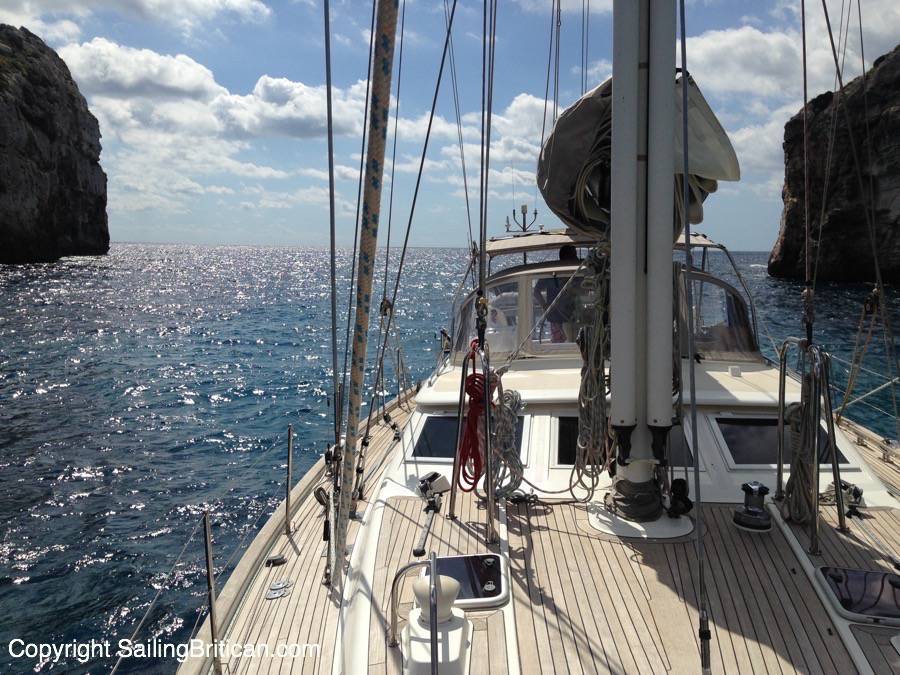Hands down, sailing around Minorca, and all the Balearic Islands for that matter, is a fantastic experience. The waters are very clean, the beaches are well-groomed, the food is excellent, the people are delightful and there are anchorages to suit everyone. Whether you want a quiet scenic bay with turquoise water or a bustling harbor filled with shops, cafes, and historical old towns you’ll get your fix.
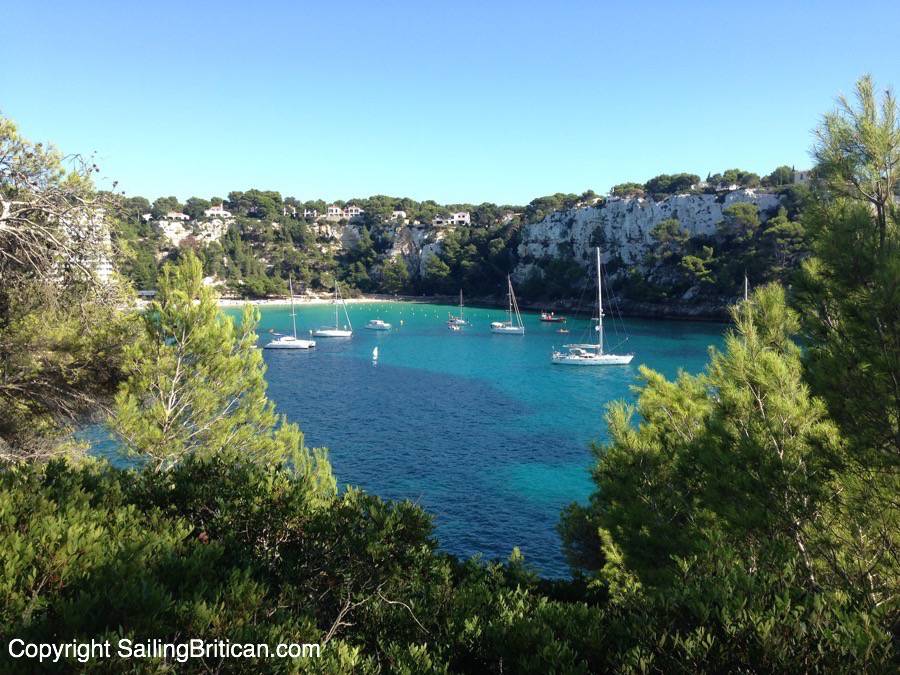
There are even party towns if you’re up for a rave or a foam party.
The Balearic Islands are nothing like Italy, Greece, or Turkey so I can’t compare and contrast – they are in a league of their own. Many bays having mooring buoys and others allow for free anchoring. And there are loads of marinas if you prefer that scene. It has it all.
As long as you plan ahead and understand the weather conditions you can surely enjoy the islands for free at anchor.
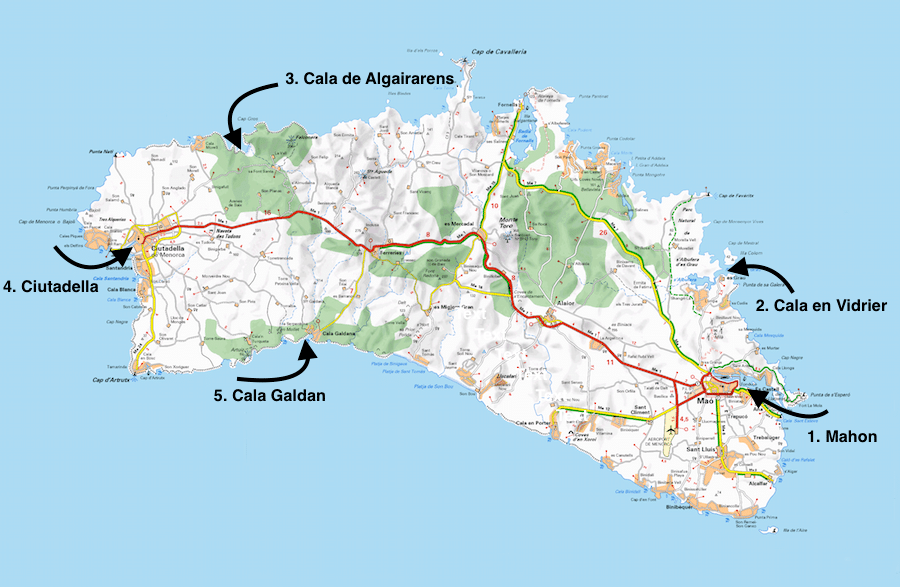
That being my quick introduction to the Balearics, I want to take you for a trip around the island of Minorca.
It’s the island located furthest to the east and the first of the Balearics that we toured before completing our circumnavigation of the Mediterranean. We purchased the boat in Palma, Majorca (the next island over) so Minorca marks our last stop before our circle completes.
I’m hoping this article and the accompanying video will create an interest for you to consider a sailing holiday, extended cruising season, or even a sightseeing trip to Minorca.
Sailing from Corsica to Minorca – how did we get to Minorca in the first place?

So…since April we’ve sailed a total of 6,445 nautical miles. Leaving from Palma, Majorca we sailed to Gibraltar, Algeria, Malta, Sicily, Italy, Greece, Turkey, and then back hitting Greece, Italy, Sardinia, and Corsica. Eventually, the time came to leave Corsica and make our last stop before completing our Mediterranean circumnavigation.
We left the majestic French town of Bonifacio on the island of Corsica at 5 am in the morning. (Watch my video on Bonifacio, here: Sailing into Bonifacio on the French Island of Corsica)
The morning sky was still pitch black and only a rubbish truck could be heard murmurings through the town.
I heard a quiet catfight and otherwise, the only noisemakers were my husband and I felt our way around the deck of the boat. The only thing to light our path was the yellow-orange town lamps. Looking around at the narrow carved rock exit I was grateful we had some light. Where’s the moon I wondered?
As we slipped our lines and slowly eased out into the cliff-sided canal towards the open Mediterranean, my husband, Simon, headed forward and we whispered our customary goodbye:
“Goodbye Bonifacio. Goodbye Corsica. Thank you so much for having us. We had a great time and appreciate your hospitality!”
When creating a passage plan, Simon aims for us to arrive at our final destination during daylight. Entering a new harbor during the day is so much easier due to obvious reasons (you can see)! On this particular trip, the plan was to leave Bonifacio, Corsica, and arrive on the island of Minorca around 7 pm the following day but we, instead, arrived at 3 pm.
The first stretch of our trip was brilliant as we were hitting speeds of 8.5 knots.
Simon uses 6 knots as an average for planning thus the 8.5 knots increased our arrival time. The first day of sailing was a bit bumpy but much to my delight I felt okay. The swell was behind the boat and with the wind pushing us; the effects of severe seasickness kept away. Woo hoo!
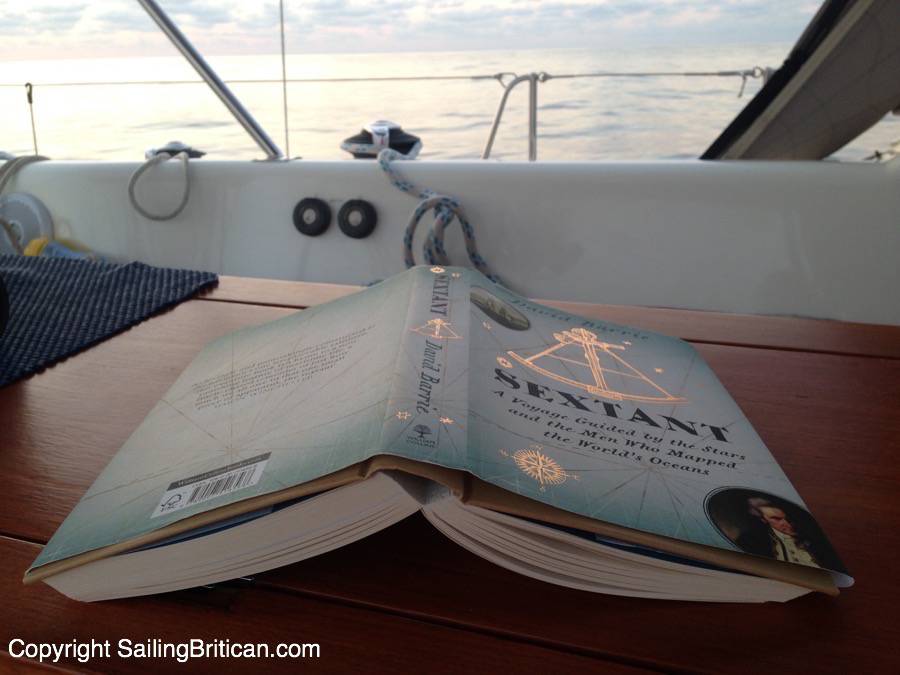
Through the day, I read an excellent book called “Sextant – A voyage guided by the stars and the men who mapped the world’s oceans,” by David Barrie.
I’m definitely not a history buff. My recollection of dates, names, and specifics is not a strength of mine. I do, however, love to read stories that are set during historical times. And what’s often stranger than fiction….(fact, of course)!
The author who wrote “Sextant” brilliantly weaved his 1973 Atlantic crossing and love for celestial based navigation in with the stories of famous explorers such as Bligh, Captain Cook, Bougainville, Beagle, and of course, and the great Shackleton (to name some).
If I had to read a full book on any of the great explorers I’d probably lose interest and quit before the book was over, but with ‘Sextant’ I really enjoyed the variety of stories. Also, the author included maps and pictures – that always spices things up a bit! What really struck me was the bravery, commitment and I’d say insanity that these explorers had.
Comparing myself, I get scared when the wind blows in a different direction.
Our founding explorers that mapped our world lived through serious life and death situations on a daily basis. Just reading about what they went through made my skin crawl with fear. It also made me realize that I need to man-up a bit.
Aside from reading, I took a nap, read some stories (from my Kindle) to my 5-year-old daughter, Sienna, and from time to time, I’d ask Simon to make me something to eat. With the sea quite choppy I only go below decks for a bathroom break or to take a nap and Simon is always happy to accommodate.
That evening I did the night watch alone from 10 pm until 1 am.
I felt okay but not great. My current trick, outside of thoroughly enjoying the beautiful blanket of stars, is to play a game on the iPad. There are two that I use to distract me from being tired and feeling green. The first is Zuma, a game where a frog shoots colored balls towards an increasing line of balls (like a growing snake). When the frog adds more than two balls of the same color, the balls explode. It’s somewhat like Bejeweled but in a different format. The object is to explode all the balls before the snake reaches a hole of doom.
The second game I play is Airport Mania where the objective of the game is to land airplanes and get them off in time. As each level increases the complexity and quantity of plane landings increase. (I add this information in as I get numerous emails from readers asking for seasickness cures!)
Anyway, part of me feels annoyed with myself for using modern technology to entertain myself.
I often think that I should endure the boredom, sleepiness, and seasickness to really suffer and thus truly appreciate my mode of travel, but I’m a wimp. I succumb to instant gratification or any gratification if I can. Maybe I’ll change over time? Perhaps when we’re sailing for three weeks during the day and night I’ll learn how to just sit in solitude? And perhaps learn to appreciate doing nothing?
(I can just picture my grandfather, age 94 now, shaking his head saying, ‘Kim – you couldn’t sit still if you had to! You’ve never had any patience.’ Heck, I’m a product of my generation.)
After my three-hour watch, I couldn’t wait to get back down into my bed. I’m not sure what hurt more – feeling tired or feeling nauseous. I suppose that’s a good thing, as I didn’t feel nauseous enough to make it my number one ailment. Often I’m so sick that I don’t even care about sleeping – I just want to die!
I hit the bed and, as usual, I did not fall quickly to sleep.
When I know I have to wake up again in three or four hours, to take over for the next watch, my inner dialogue goes like this:
Kim 1: “Okay Kim, you’re not going to get your 8 to 12 hours of sleep tonight so quickly fall asleep!”
Kim 2: “Yes, I’m trying to fall asleep but I can’t!”
Kim 1: “Come on…you’ve got to be kidding me. My body and mind are so tired.”
Kim 2: “It’s not my fault, it sounds like there’s a can of baked beans rolling around in the cupboard. I should get up to get it but I know if I remove that noise something else will only take it’s place so I’m just going to lay here annoyed at the bang, roll, bang sequence.”
Kim 1: “Get up and find the noise. Come on, it might be hours before you fall asleep and then you won’t be able to sleep at all!”
And the dialogue goes on until I eventually fall asleep. I wonder if I’m the only person that finds it difficult to sleep between night watches? Most of the salt sea dogs I know say that they hit the pillow sleeping.
Around 5 am Simon woke me up. Interestingly, I was able to easily wake from my slumber, climb up into the cockpit, and first watch the moon rise. Aha – that’s where the moon was hiding – below the horizon! Thereafter Venus came up (I know it was Venus because my iPhone Sky app, when aimed at a star/planet tells me what it is) followed eventually by a beautiful golden sun.
Yes, I am hooked on modern technology but that doesn’t mean I don’t take the time to truly absorb my natural surroundings.
Sitting in the cockpit, alone, and watching the sky change from darkness to light observing the celestial delights is an awesome experience. More and more I’m starting to recognize constellations, planets, and their changing position in the night’s sky. It feels great. Who knows, perhaps I’ll get myself a sextant and let my inner geek really come out?
On day two of our sail to Minorca, the winds died down and we eventually had to put the engine on. One of these days I think we’ll be in a position to just drift until the wind comes but for now we use our engine when the wind fails to propel us forward.
Upon entering Spanish waters, Simon pulled out our bag of flags and asked Sienna to find the Spanish maritime flag. The duo then did the task of pulling down the French flag to raise its replacement. That’s when it dawned on me that we were entering a new country with different foods, customs, and yet another language.
Up until then, we’d been immersed in the Italian and Greek way of life.
Time in Spain seemed like a breath of fresh air. Furthermore, I took four years of Spanish in high school, traveled through Spain quite a bit, and, considering I’m American, feel very comfortable with the Spanish and Mexican cultures.
Entering Spain felt like coming home to something I knew rather than exploring a new land. With all the newness we have to encounter on a daily basis, it was nice to feel comfortable and at ease for once.
I didn’t have to print out a page of the key language phrases, as I already know them.
I didn’t have to worry about what the people were like as the Spanish are genuinely lovely people. And I certainly had no concerns about the food – Tapas (small portions of Spanish recipes) must be the best culinary option possible. Getting loads of different dishes with different tastes is brilliant.
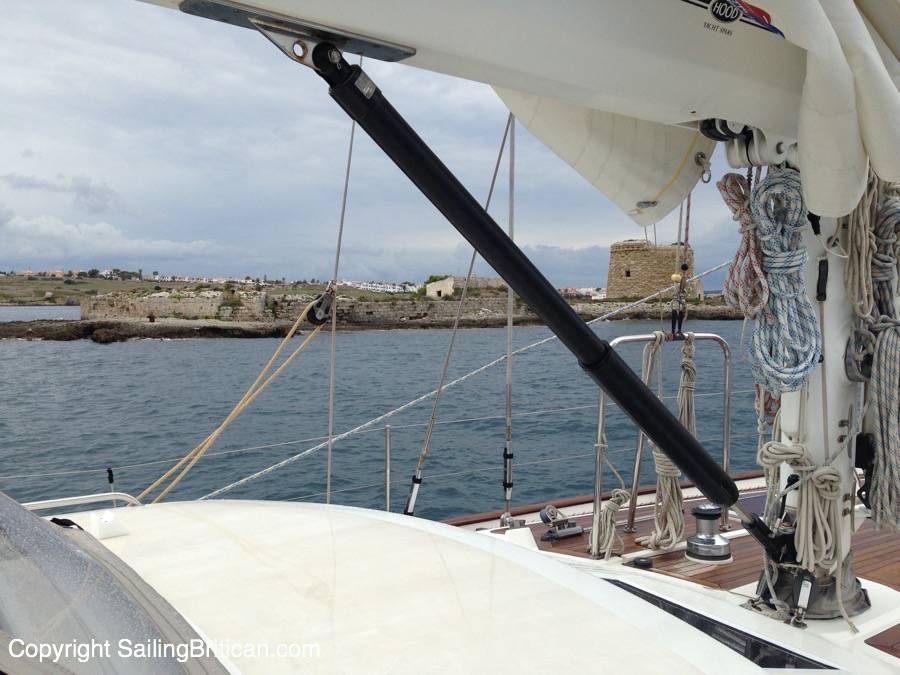
Eventually, we saw Minorca and the first thing that caught my eyes was massive guns at the top of the cliffs upon entering Mahon, the main city. Simon and I decided they were remnants of WW2 and later discovered the Brits sold the Minorcan’s guns after WW1. Much to Simon’s delight, we took a tour of the Mola, an imposing Spanish fort at the entrance to the Mahon harbor (more on that to come).
Not having a pilot book, or a book that explains anchorages, marinas, facilities, surrounding area, we were sailing somewhat blind.
We had maps, our plotter (GPS Tom-Tom system), and our backup Ipad navigation system so we could see the sea but not the details about the land so much. Our time in the Balearics was going to be very short so the cost of an expensive book didn’t seem necessary.
We were told of a bay that allowed for anchoring so headed there first. Much to our dismay, the bay was full so we headed for the main port. We passed the old fort, noticed nice properties lining the harbor and loads of palm trees. We arrived during a cloudy day so the sights weren’t glowing with the golden rays from the sun but nevertheless it was an enjoyable cruise up towards the main town.
Where are we going to moor up?
Usually, if you slowly park your boat in front of a marina someone eventually comes out on a dingy and asks you if you want a berth. We didn’t have any VHF marina call signs (noted in the pilot book that we didn’t have) so we couldn’t call around. We couldn’t even call up and say, ‘Hey – we’re here!’
As usual, a lovely marina attendant came out and said, ‘Hola, are you looking for a berth?’ He gave us a price and then we then respond asking, ‘Is that the best deal you can do?’ and the bartering ensued. On this particular occasion, we got the cost down from €77 to €50/night. It’s important to note that we entered Minorca at the end of the season (in September) so prices were vastly discounted. I’m sure the same marina charges €200+/night during the high season.
With an agreement made, Simon started to back the boat in and I prepared to throw the aft lines back to the attendant, now on the wall. As we neared the 10’ mark towards the wall I heard someone yell out, ‘You’re Kim – aren’t you?’ Our new neighbor was a lovely man that corresponded with me through my website and followed our adventures. It’s a small world, isn’t it?
After securing the boat, we met our neighbor’s family, enjoyed a beer and swapped stories about good anchorages.
While tied onto the wall for four nights we eventually met three boats that will be joining us on the ARC (Atlantic crossing in Nov/Dec), gained great insight into the best bays, and even acquired two ginormous tuna steaks from another neighbor. Freshly caught tuna – yes, please! How often do you meet someone for a ten-minute chat and then end up with free fish? In the sailing world, all sorts of great things like that happen.
In return for the fish, I grabbed three packages of my Britican Galley Herb and Spice Blends and passed them over just as our new friend was leaving the mooring. Sailors are amazing at giving things out to each other or swapping one item for another. We’ve swapped pumps, clothes, wine, and food.
Hanging out in Mahon for four days was very enjoyable.
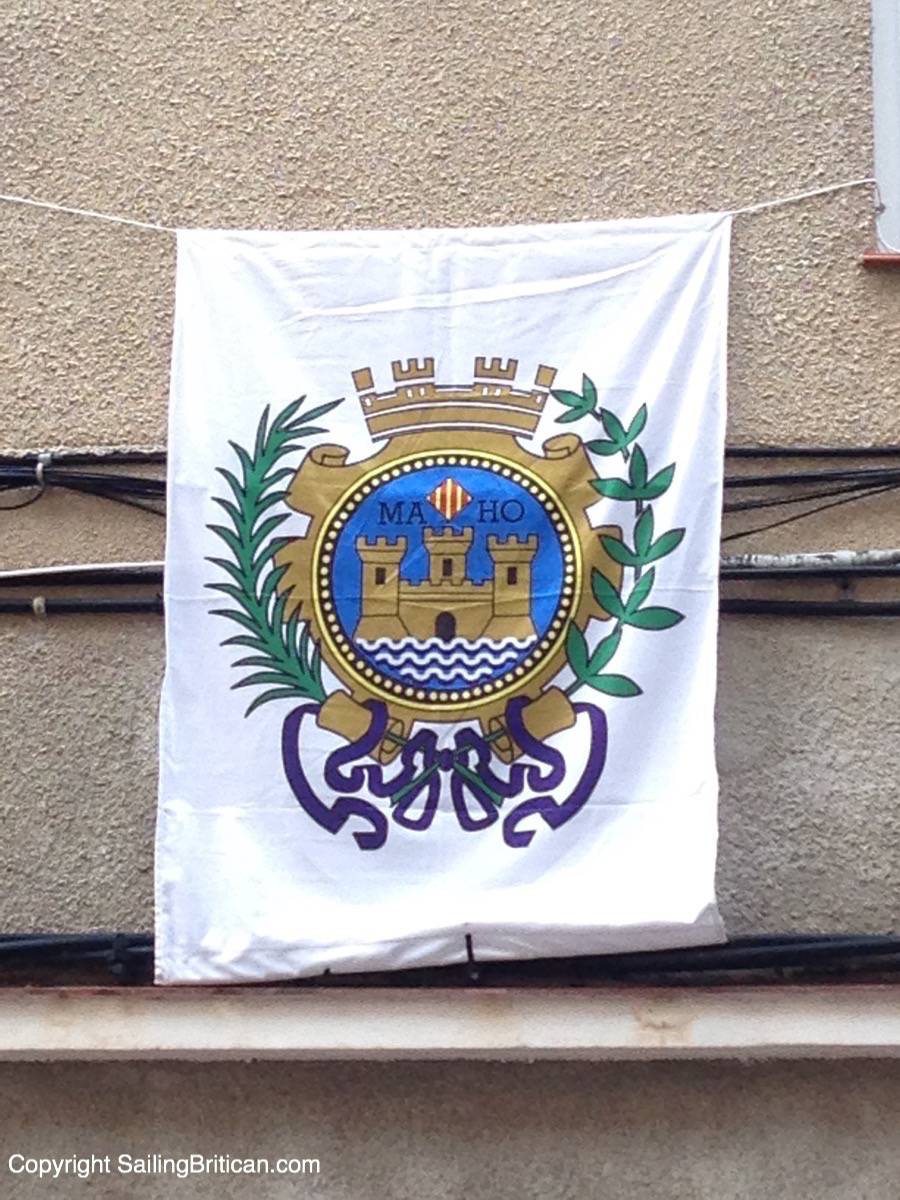
Aside from walking around the beautiful ‘Old Town,’ we paid a visit to a fishing shop to get some more lures for our Atlantic crossing. Simon also purchased another trolling fishing pole and reel. The plan is to have two lines out at all times and the hope is that we’ll enjoy fresh sushi and then a variety of fish dishes as we make our way to the Caribbean. Thankfully one of the crewmembers joining us on the ARC is very comfortable with fishing, cleaning and even cooking it.
Thankfully I’m off the hook 🙂
We also enjoyed some lovely tapas dishes from a variety of restaurants. And I, of course, enjoyed one of Spain’s most traditional dishes – paella. The food at every restaurant we tried tasted fantastic. Even the places that we stopped for a quick bite that looked touristy still had great food.
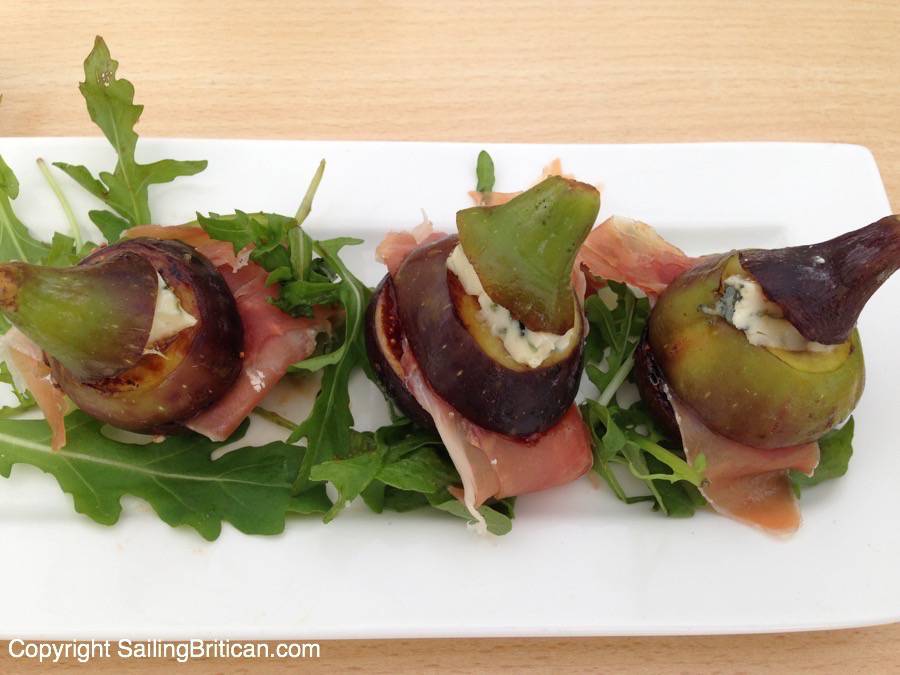
One day we spent the majority of the day at La Mola – established in the late 1700s.
The fort was started by the British and then finished by the Spaniards. It was used for defenses but never saw any action. Aside from being run down, the fort is still in an amazing condition.
For the first part of the tour, we paid €20 to hire a golf cart to drive out to the big guns on the clifftop (Sienna’s little legs would have never made it) and see the further-reaching points. After we returned the cart, we then spent a few hours walking around the rest of the fort. Simon tends to listen to the audio guide while I have Sienna make up stories about what things are.
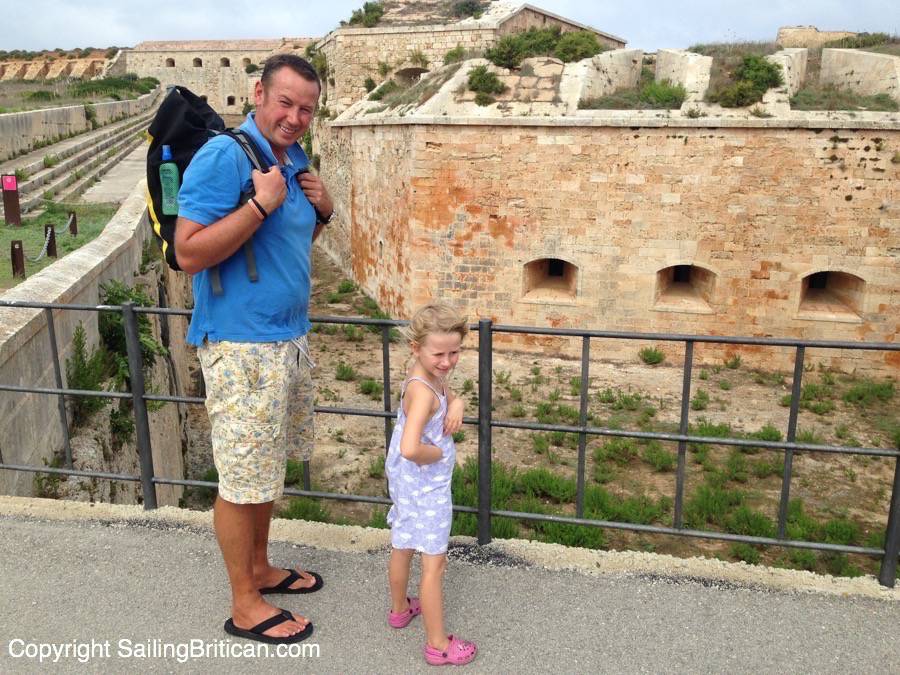
For example, when I asked her what this piece of machinery is (see picture below), she spent five minutes telling me that it was a movie projector and elaborating on how it works. Another story she told me centered around the water filtration system.
There was a set of pools one lower than the other and Sienna surmised that it was a Jacuzzi park.
The story I enjoyed the most (and included in the video) is about the metal sculpture that we discovered in one of the fort’s rooms. We’ve been learning about the Greek Gods recently in addition to Michelangelo so it’s funny to hear how she recalled her educational materials and used them to describe a foreign piece of art.
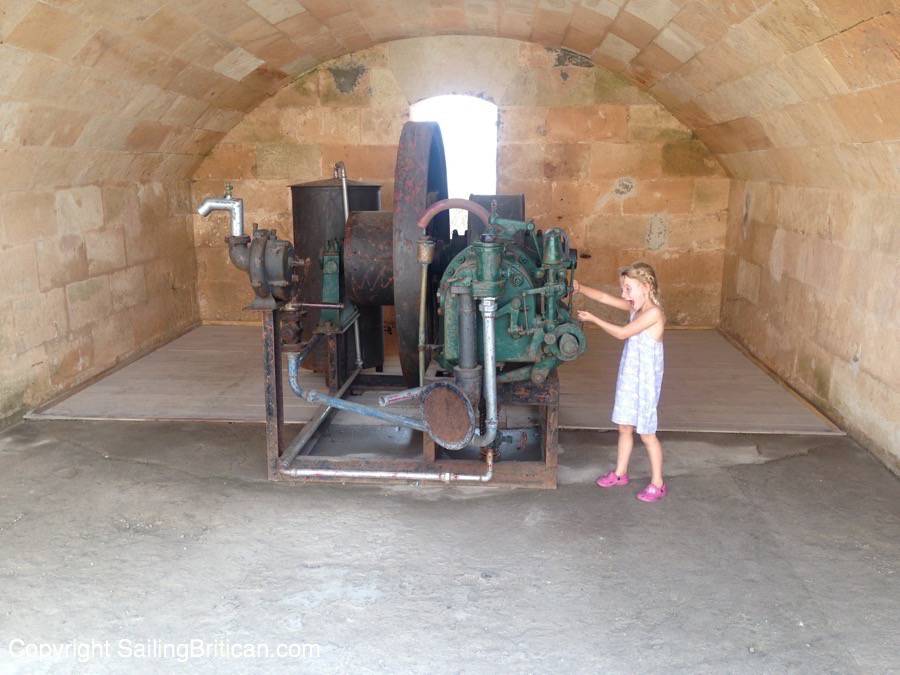
That day after our La Mola visit, Simon hired a scooter and took Sienna to a tiny zoo.
They spent the day looking at snakes, owls, horses, kangaroos, emus, ostriches, crocodiles, monkeys, and more. While the two kids were off to the zoo, I spent my free time writing a couple of articles for the website, downloading educational materials for Sienna’s homeschooling, and feebly attempting to answer all the emails I had stacking up.
With one last lovely meal in Mahon, went to bed, woke the next day, and said our goodbyes. We enjoyed a lovely sail out of Mahon and up and over to Cala en Vidrier.
Cala en Vidier
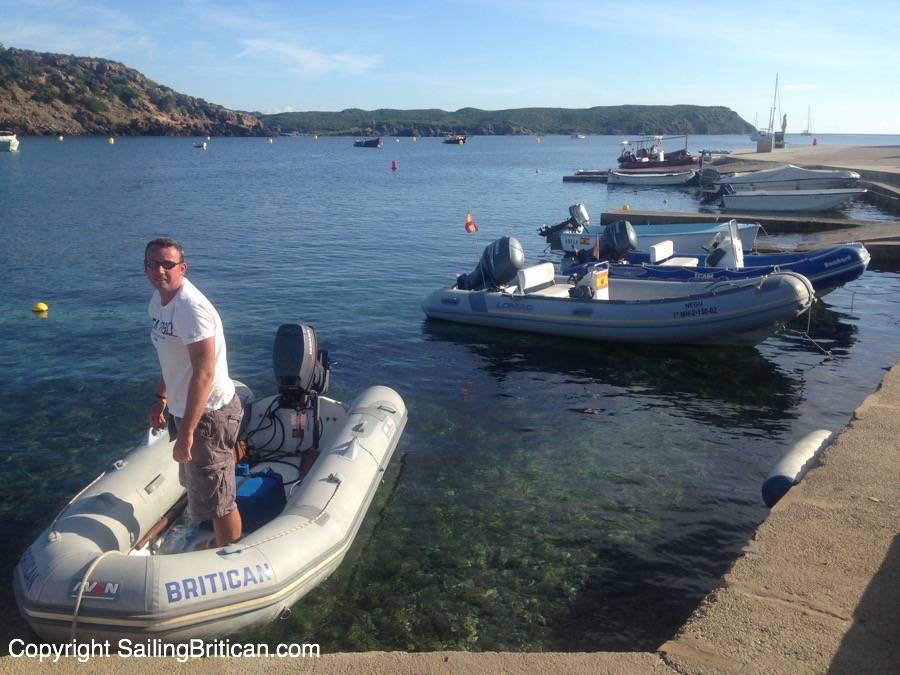
The beautiful expansive bay of Cala en Vidrier sports a lovely beach, walking trails, a few places to eat, and a tiny grocery store. You can easily hire kayaks from a shop in the town and so-so wifi was easy to get from all the cafes.
With a quick walk from the pontoon, there’s a substantial rubbish/trash dump filled with every recyclable option available.
The bay was very quiet during our visit but I imagine during the high season there are loads of boats and day-trippers to enjoy the lovely views and beautiful sandy beach.
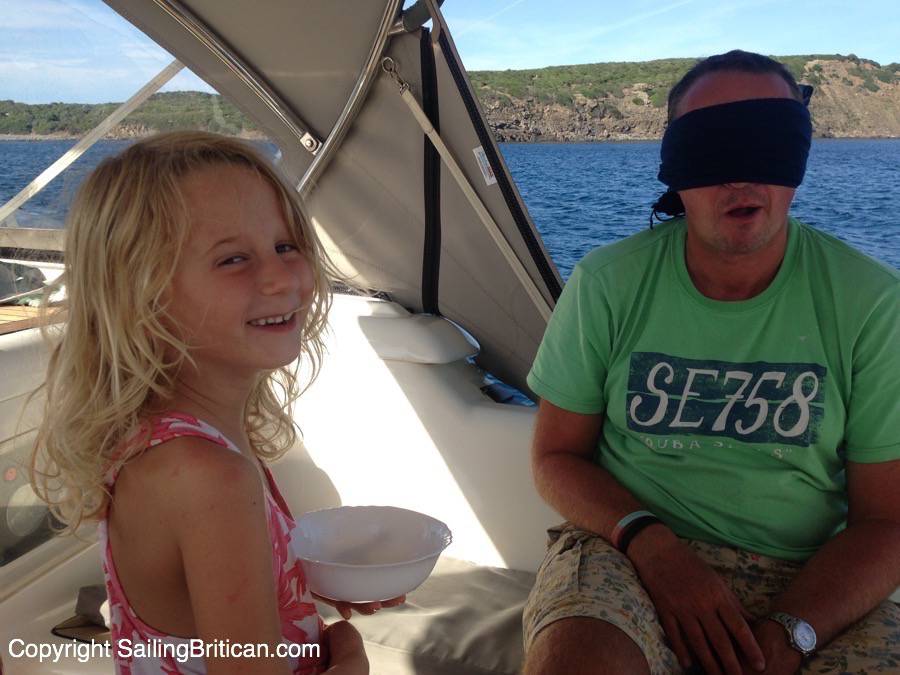
Simon, Sienna, and I ate dinner on board. Sienna wanted to blindfold us and feed us food, so we all took turns finding things in the fridge and cupboard to double up as goats eyes (pickled onion), cow tongue (pepperoni), monkey brains (cold spaghetti) and goblin blood (honey).
You’d think that we’d get bored while at anchor but, seriously, there never is a dull moment. Especially with a five-year-old on board.
When we went into the town we spent an hour on the wifi and paid a visit to the grocery store for milk and bread.
After our return to the boat, we lifted anchor and headed to Cala de Algaiarens.
Cala de Algaiarens
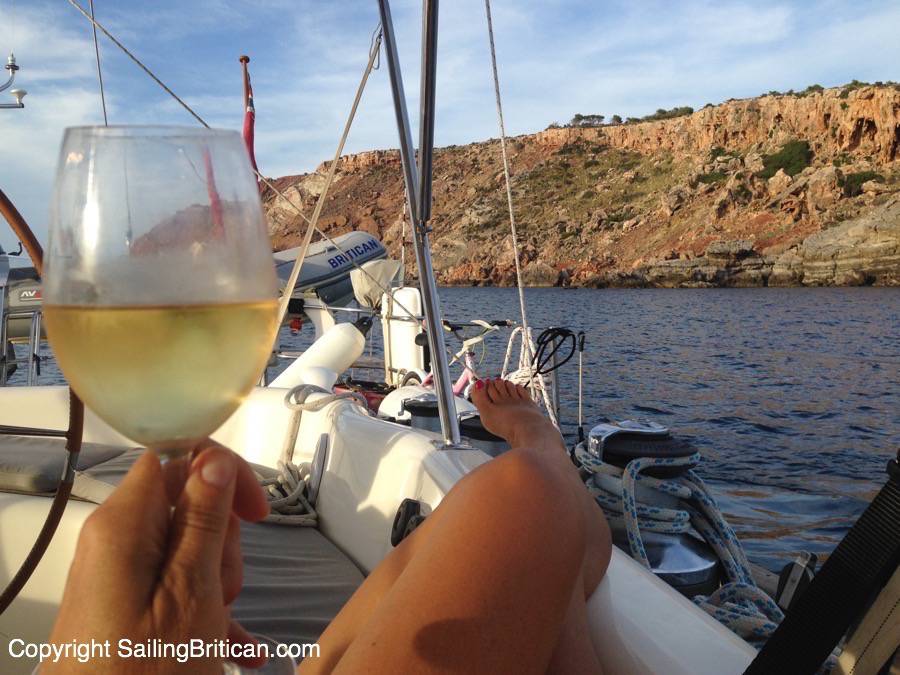
Our trip to Cala de Algaiarens was very enjoyable but quite rocky – with the wind behind us we used our mainsail only. It was too windy to have both sails out and I had to remain on deck for the duration of the bumpy trip to avoid feeling too green with seasickness.
Every new point of the island that we passed provided another lighthouse to check out and admire.
As you look down the coast you simply see low cliffs, however, lighthouses seem to pop out of nowhere when you take another glance.
Upon entering the bay we noticed that the rock face was red rather than gray – something we hadn’t seen on Minorca thus far. Furthermore, it was slanted in such a way that I could imagine the rocks below the ground pushing and grinding the current rock face up to the seeable world. I sat staring at the rock face for a good half hour sipping my wine.
Simon dropped the dingy down and took Sienna and me to the beach.
It must be one of Minorca’s most beautiful beaches – when I went to take some pictures I discovered that my phone was dead so you’ll have to visit the island to see this beach for yourself.
There were hundreds of people all enjoying the sun, sand, and sea. When we pulled up on land, we beached the dingy, walked up the path leading away from the beach, and found a parking lot. The map showed a town but it was a bus ride away. There were no restaurants, bars, or a souvenir shop in sight. It was actually nice to find just a beach.
Back at the sea, Sienna took her dress off and went swimming along the beach for a while.
The following day we set off for Cuitadella and unfortunately the five weather forecasts we received were not accurate. We were expecting Force 4 -5 with 1-meter waves and when we rounded the northwest corner of Minorca we found ourselves in Force 6 – 7 with 3-meter waves. Force 7 is considered ‘gale force’ so quite strong.
Sienna puked.
I held it together for a while but what pushed me over the top was the marina at Cuitadella telling us the weather was too bad we couldn’t enter the channel. Imagine enduring a couple of hours of rough weather expecting that our destination was in sight only to be told that we had to go back to where we came from!
From Cuitadella back to Cala de Algaiarens I laid in the cockpit hugging Sienna hoping for a quick return. Once we found ourselves along the top of Minorca the waves were much better and we were going with the wind rather than against it.
The problem I had is that full-blown seasickness had hit me. I was down for the count. Once we anchored Simon took me to shore. I’m such a wimp. If it wasn’t for the 40 things that make full time liveaboard cruising rock, I don’t know how I’d keep living on a sailboat.
Cuitadella
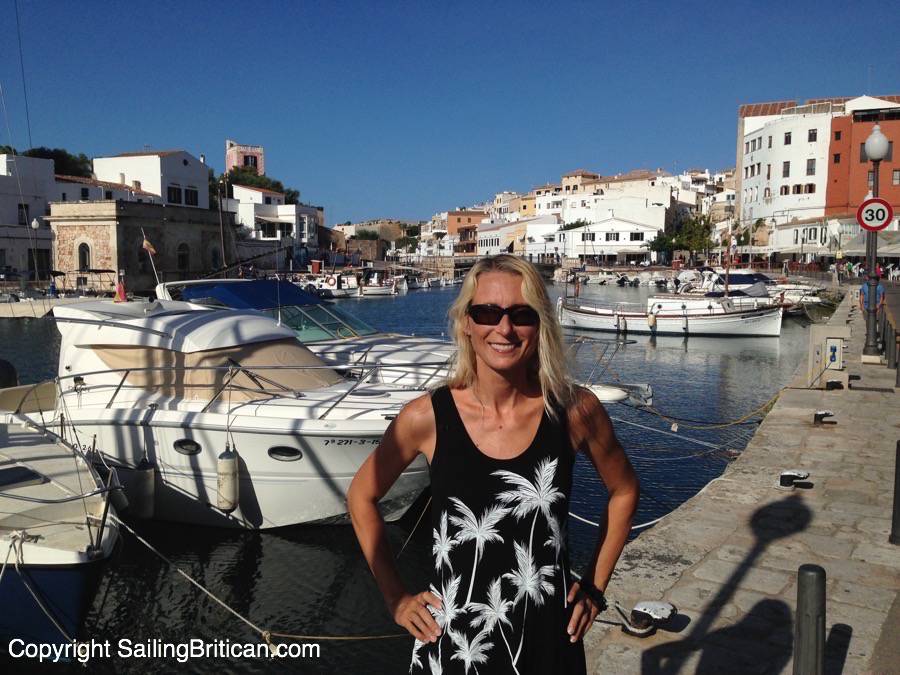
The following day we tried to phone the marina at Cuitadella but the number we had didn’t work.
We didn’t have an Internet connection or a pilot book so once again, we decided to head to the town and hope the weather was better. When we rounded the northwest corner it was still choppy with quite a swell but the wind was calmer. I asked Simon to use the VHF as soon as we could see the entrance to the town.
A lovely woman responded and said, ‘your draught is too deep for the marina so you might be able to moor up in front of the restaurant. We’ll have to see…’
When she said, ‘we’ll have to see’ I thought what does that mean? Does that mean that we might hit the bottom? Does that mean that we might go into the town and not be able to stay?!
I gave myself an internal slap in the face, told myself to ‘get to grips,’ and gave my PMA (positive mental attitude) a jumpstart.
As we sailed along a very narrow canal, Sienna and I went to the bow of the boat to find the kind lady. She said she’d wave us in.
It quickly became apparent to us that we were a bit big for the port. In most places, we’re small fry, but in Cuitadella we were the big kids on the block.
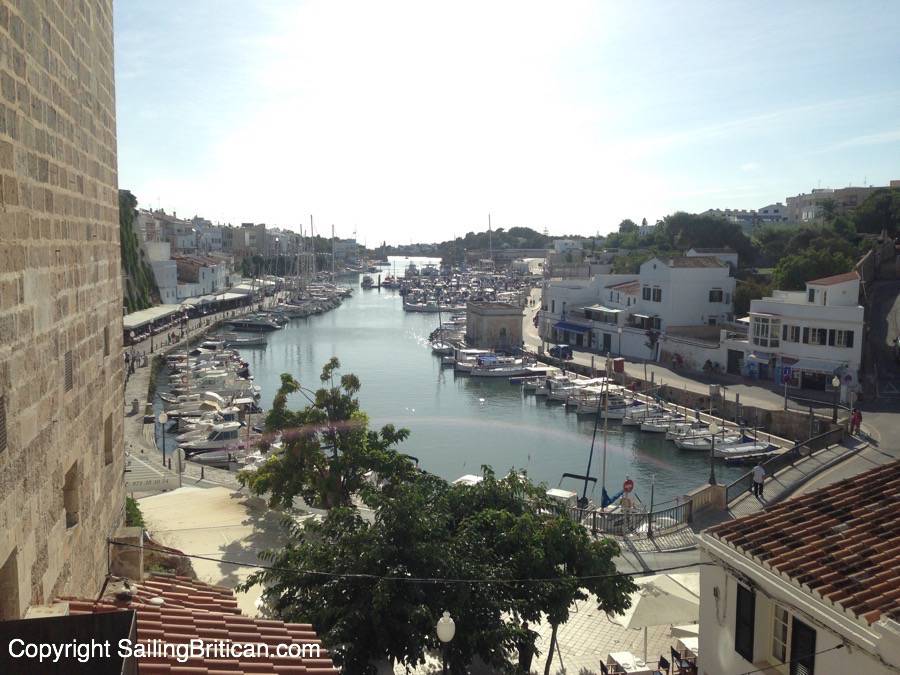
Sienna spotted the marina attendant first and then we yelled back to Simon. We had a full audience of lunch-goers ready for some entertainment so I quietly prayed that 1. We’d moor up with ease and 2. We wouldn’t hit bottom.
Due to the storm the water was so murky, I couldn’t see the depth. I’m sure Simon was watching our depth but I just kept telling myself PMA, PMA, PMA.
Everything went fine.
We moored up and had a handful of people come up and thank us for the entertainment. We were massive compared to all the boats around and Simon had to use our bow thrusters to get into the space. The bow thrusters are very loud devices that provide propulsion in the bow so we can move the bow of the boat left and right.
The echo of the thrusters got everyone’s attention.
Simon backed the boat into the space, I threw one backline, then the other…and then I grabbed the first backline and pulled it onto the boat to secure. Then the second line I secured. Grabbing my pole, I then picked up a line that’s permanently fixed at the marina that acts as an anchor line. I walked it up to the bow of the boat and then tied it onto the front cleat. And usually, I do that for both sides of the boat if the marina supplies two ‘slime lines’ – they’re called that due to all the shells, barnacles and slime on the line.
Then, we spent a good 15 minutes getting our passerelle, or gangplank, set up so we can get off the boat. So, for a good 20 to 30 minutes I’m sure we provide an interesting show.
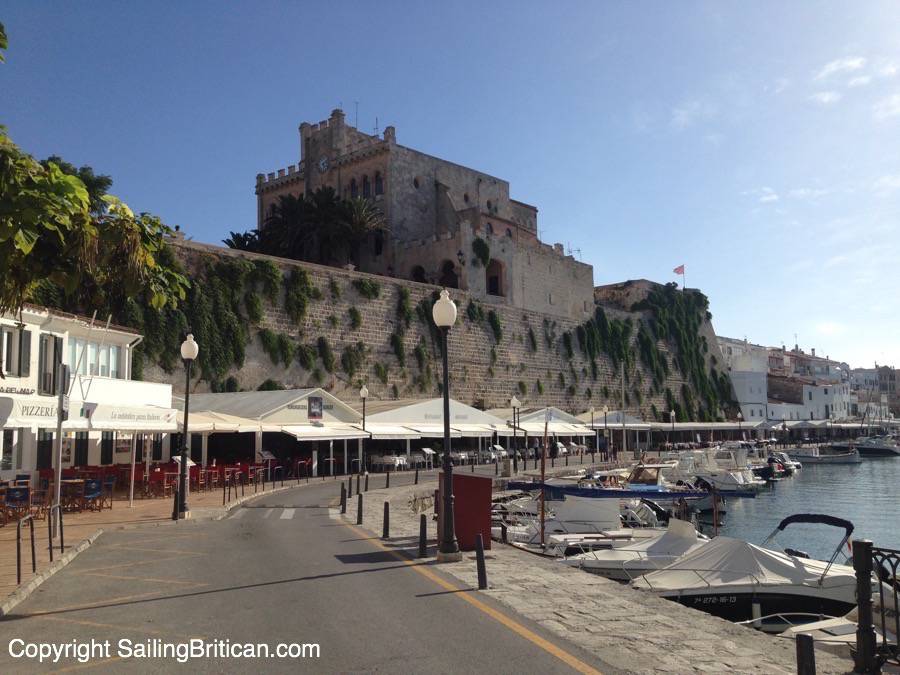
When we left Ciutadella we had even more on-lookers.
I felt a bit embarrassed and didn’t know where to look as people videoed and took pictures. Thankfully I showered recently and looked okay (not that the on-lookers were looking at me!)
While at Cuitadella we transverse the lower port area – Sienna on her bicycle – and then went up into the old town. There’s a nice park surrounded by cafes so Simon and I enjoyed a beverage as Sienna climbed a jungle gym.
The fee for mooring up in Cuitadella was around €100 so we didn’t want to stay longer than one evening. Taking advantage of the restaurant at the end of our gangplank, we fed Sienna early, put a movie on in the back bedroom for her, and then reserved a table closest to the boat.
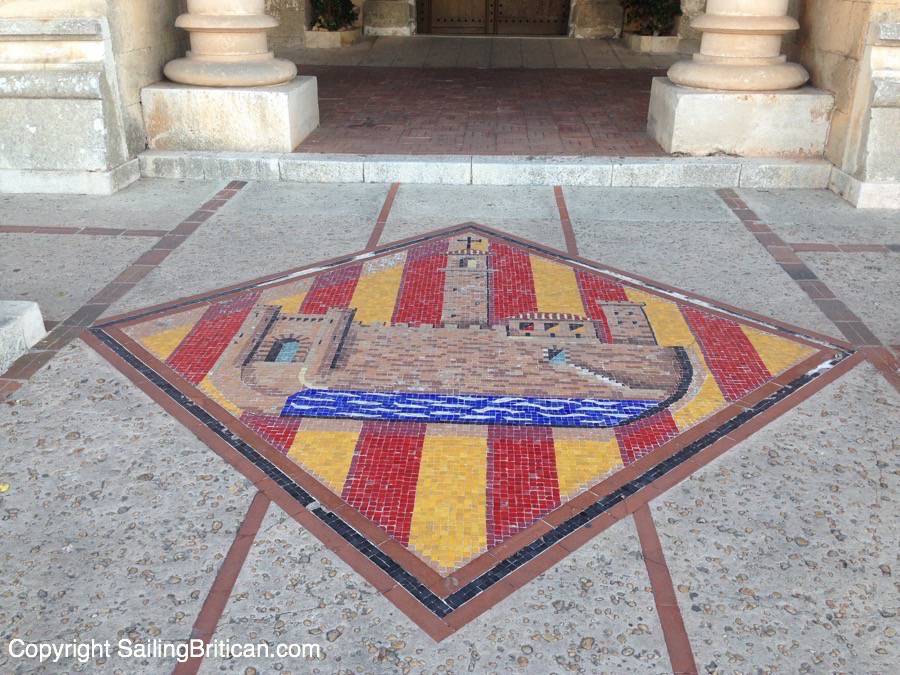
I wish I could say I romantic dinner was romantic but Sienna popped over on several occasions to say ‘hi’. And it didn’t help when our waiter started giving her sweets! Oh well, it was worth a try.
The next morning, we went to the grocery store to grab some milk, bread, and snacks, said our goodbyes, and then watched a group of people take pictures and video’s of us and we left the jetty.
Our next and official last stop on the island of Minorca was the amazingly beautiful bay of Cala Galdan…
Welcome to Cala Galdan!
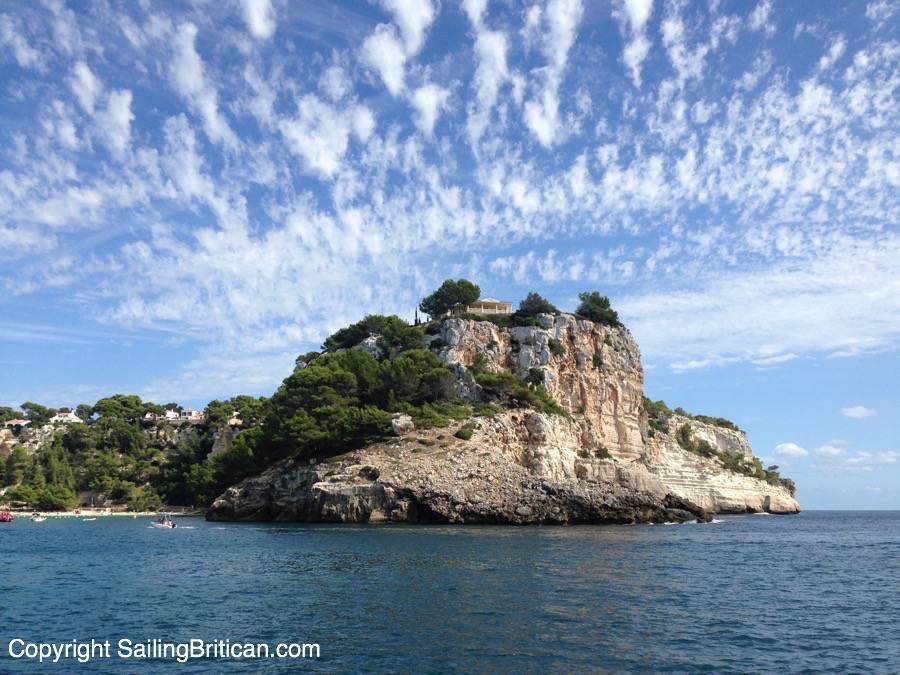
When we first arrived at the bay there was a massive brand new catamaran in the middle of the bay – closer to the entrance rather than the beach. Then there were about five smaller monohulls all anchored within a few feet of each other right at the border of the swimming zone.
I couldn’t help but wonder why the majority of boats crammed into one area as the depth of the bay was very low (around 5 to 7 meters) all around. We cautiously took a spot between the cat and the group of monohulls providing a lovely amount of space to spin on our anchor.
My rule of thumb for anchoring is to start at 3x the depth of the water we’re in.
So, if we’re in 5m of water, I’ll start off with 15m of chain and then increase to 5x. In 5m of water, I’ll end up putting 25 to 30m of chain out. If rough weather is coming, I’ll increase that ratio to as high as I can go without worrying that we’ll swing over someone else.
In the Balearics, with many charter boats and smaller bays, I noticed that most boats were lucky to put out 2x the depth. I’m sure that during the busy season, you’d have to get used to having very little chain out so that your swing pattern would barrel over other boats. Lucky for us it was late in the season and we were able to have loads of space.
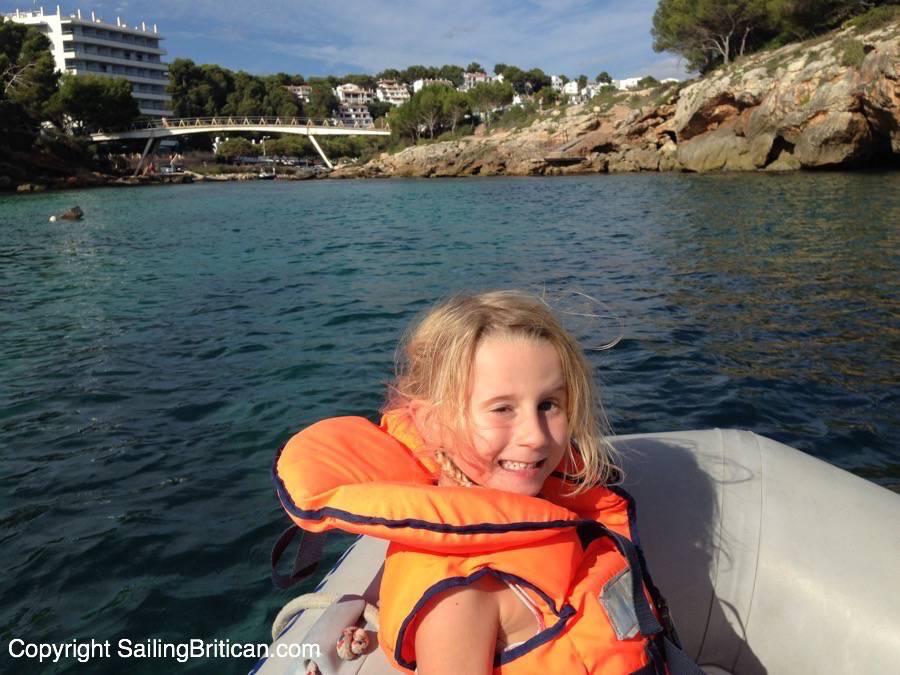
After we anchored in Cala Galdan, Simon dropped the dingy, went to land with Sienna, and scoped out the scene. The duo enjoyed a soft drink and nose around the town. Soon after they came back to the boat to challenge me in a game of miniature golf. How could I say ‘no’?
There’s a cute little restaurant that offers miniature golf, small water slides, a children’s pool, and a playground called Tabogan.
We spent our first day there playing golf and the second day we spent time on the pristine beach. The spot was perfect – it had restaurants, a couple of grocery stores, some shops, a lovely beach, and fun stuff for children.
By the time day 3 came, we upped anchor and went in search of another bay along the south coast. We entered a few cliff sided narrow anchorages but felt uneasy. As a boat left we asked the skipper what the mooring was like (lucky for us he put his clothes on before we came within earshot). He yelled over that the swell made the line to shore snap harshly and it wasn’t very comfortable.
Each bay we went in felt too confined and the swell seemed to be increasing so we went back to Cala Galdan.
At least we had the opportunity of seeing most of the south coast. In the end, we circumnavigated about 80% of the island.
For our second arrival at Cala Galdan, we were the only boat there so we anchored closer to shore hoping to reduce the effects of the increasing swell. The wind was blowing us one way and the swell was hitting us another causing the boat to rock back and forth in a dramatic fashion. If I had known how bad the swell was going to get I would have upped anchor and sailed to the north of the island to find calm seas.
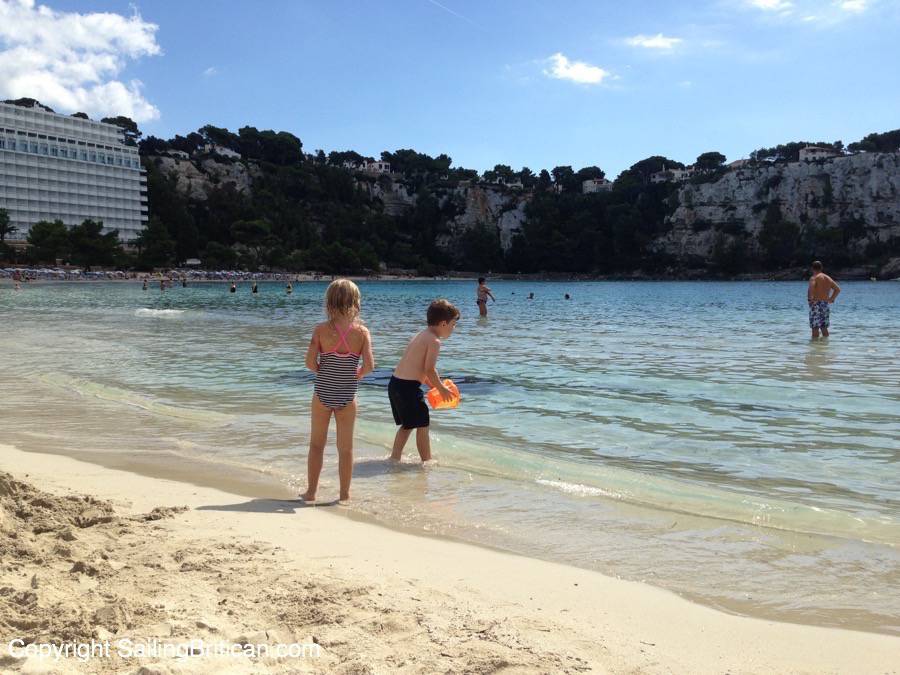
We packed our land bag (laptop, Ipads, sweatshirts, glasses, notepad, extra clothes for Sienna and sun cream) and went to the shore. Sienna met a lovely 6-year-old British boy and spent hours with him running around the playground. She also met a kind Spanish girl that was eager to play after her boyfriend left.
The three of us stayed on land for as long as possible and then headed back to the boat. The swell was terrible – the worst I’ve ever experienced in my life. After two years of sailing through a variety of conditions, the swell was causing us to rock so much that things were falling all over the place. The cupboards were rattling and there was absolutely no stability.
At one point I thought I was going to break as the sound and the movement just became too much.
In the end, I just had to let go and allow the situation to happen. At 3 am in the morning there was nothing I could do.
On day five we got off the boat and much to our delight, Sienna’s boyfriend was back. The children played for a while together and when the family moved to the beach, we went with them. We spent the whole day with the little boy’s parents and grandparents – it was a relaxing, ‘normal’ day. Instead of trying to get work done (write an article, work on my store, etc) I realized the opportunity to enjoy a bit of social time and it was wonderful.
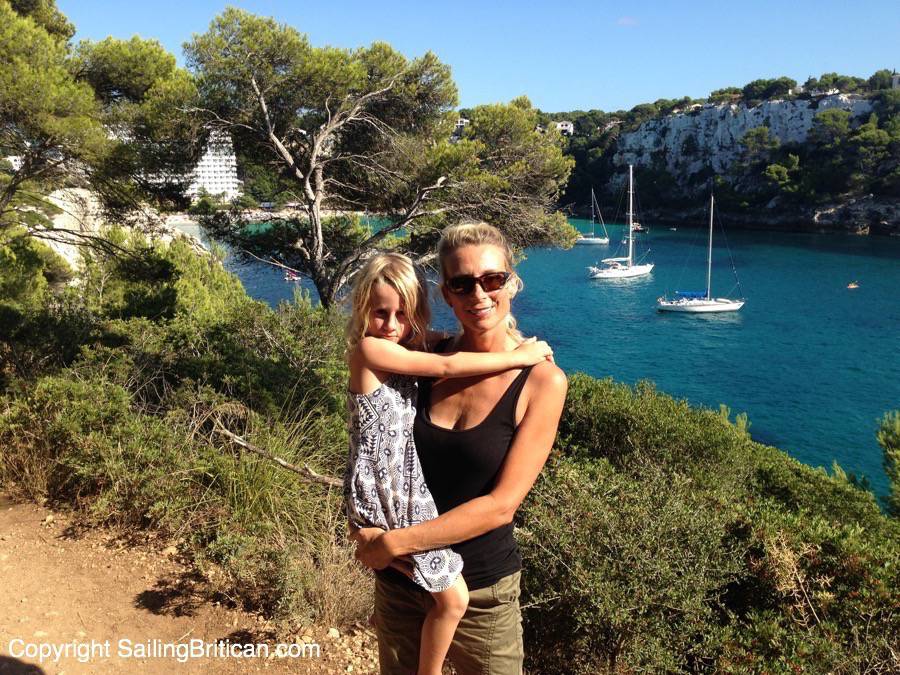
When we finally went back to the boat we were very surprised to find a few charter boats literally anchored on top of us. The swell had died down quite a bit and there was very little wind. When there’s no wind, boats tend to swing on an anchor independently. In other words, you need wind to allow all boats to aim in the right direction apart from each other.
With the lack of wind, when one of the boats came within 5’ of us, my husband kindly asked the skipper to consider moving.
A long discussion ensued and the skipper didn’t think there was an issue.
Simon explained that we had 40m of chain out, we weighed almost 35 tons and when the wind comes there’s a high chance we’ll hit them. The skipper’s response was, ‘well why don’t you pull some of your chain in.’
In the end, Simon gave up and yelled over, you don’t care if the boat your on gets damaged as it’s a charter boat. This boat I’m on, however, is my home! We upped anchor and moved to the middle of the bay.
After listening to the skipper on the other boat I think the poor guy just didn’t know what to do. In the morning he said sorry and thanked us for moving. The general rule is that whoever anchors first has the right to stay if there’s a proximity issue.
What I couldn’t understand is that the bay is huge yet all the boats anchored within feet of each other in this one spot. Perhaps they were told it was the only safe spot? Who knows.
For the last day of our week-long stay in Cala Galdan we had guests!
One of Simon’s ex-coworkers, Doug, flew out to Minorca with his lovely wife Liz to enjoy some late summer/early autumn son. Fortunately, the weather was good and we took the couple for a nice sail along the south coast of the Minorca. (I’d upload a photo of them but this wifi is killing me…it’s taking hours of failed attempts to get pictures up so I’m giving up…)
While munching on pretzels, potato chips, and nuts we talked about all sorts of things – both boat related and just life in general. It was nice to have visitors. It was fun to show friends what our lifestyle is like and why we do what we do.
Later on that evening, we all met up for dinner and enjoyed some excellent tapas from the Alaska restaurant (strange name?). The night came to an end, we said our goodbyes and prepared to leave for Majorca, the next Balearic Island heading west.
Our 15 days in Minorca finished (not that we planned a certain amount of time) and we said ‘Goodbye Minorca. Thank you for having us and thank you for allowing us to have such a brilliant stay.’
On the whole, Minorca is a fantastic island to tour by sailboat. There are loads of bays, lovely anchorages, and good marinas. During the summer I’m sure the area gets busy so you’ll have to be okay with anchoring with limited scope but that’s what an anchor alarm is for – eh? My suggestion would be to hit the island in September when the majority of people have left so to benefit from quite bays, good weather, and fewer crowds.
From the Balearics, we stopped in Spain (Marbella), hit Gibraltar, and then made our way down to Gran Canaria to prepare for our Atlantic Crossing.
Check Out Some Other Areas Around The Mediterranian
If you’d like a breakdown of all the places we’ve visited while sailing the Mediterranean please read our destination overview: Sailing The Mediterranean. Otherwise, check out more posts about our time spent in Sicily.
